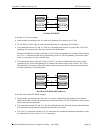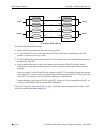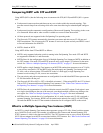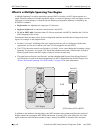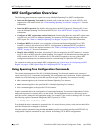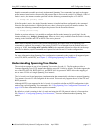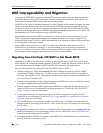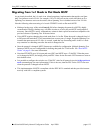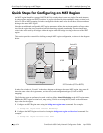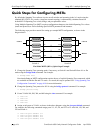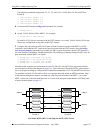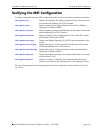
Using 802.1s Multiple Spanning Tree MST Interoperability and Migration
OmniSwitch 6600 Family Network Configuration Guide April 2006 page 6-13
Migrating from 1x1 Mode to Flat Mode MSTP
As previously described, the 1x1 mode is an Alcatel proprietary implementation that applies one Span-
ning Tree instance to each VLAN. For example, if five VLANs exist on the switch, then their are five
Spanning Tree instances active on the switch, unless Spanning Tree is disabled on one of the VLANs.
Note the following when converting a 1x1 mode STP/RSTP switch to flat mode MSTP:
• Making a backup copy of the switch boot.cfg file before changing the protocol to MSTP is highly
recommended. Having a backup copy will make it easier to revert to the non-MSTP configuration if
necessary. Once MSTP is active, commands are written in their explicit form and not compatible with
previous releases of Spanning Tree. If the need arises
• Using MSTP requires changing the switch mode from 1x1 to flat. When the mode is changed from 1x1
to flat, ports still retain their VLAN associations but are now part of a single, flat mode Spanning Tree
instance that spans across all VLANs. As a result, a path that was forwarding traffic in the 1x1 mode
may transition to a blocking state after the mode is changed to flat.
• Once the protocol is changed, MSTP features are available for configuration. Multiple Spanning Tree
Instances (MSTI) are now configurable for defining data paths for VLAN traffic. See “How MSTP
Works” on page 6-4 for more information.
• Note that STP/RSTP use a 16-bit port path cost (PPC) and MSTP uses a 32-bit PPC. When the proto-
col is changed to MSTP, the bridge priority and PPC values for the flat mode CIST instance are reset to
their default values.
• It is possible to configure the switch to use 32-bit PPC value for all protocols (see the bridge path cost
mode command page for more information). If this is the case, then the PPC for the CIST is not reset
when the protocol is changed to/from MSTP.
• This implementation of MSTP is compliant with the IEEE 802.1s standard and thus provides intercon-
nectivity with 802.1s compliant systems.



